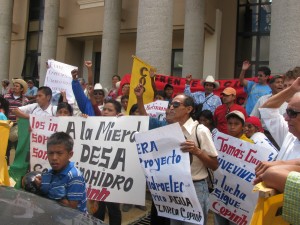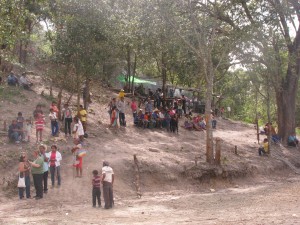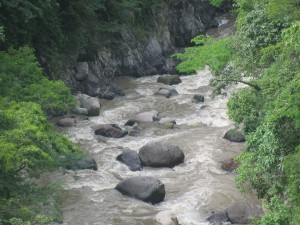 Note: This article is based on the Rights Action report released this week, “The Agua Zarca Dam and Lenca Communities in Honduras: Transnational Investment Leads to Violence against and Criminalization of Indigenous Communities”. Follow the link to read the full report and take action.
Note: This article is based on the Rights Action report released this week, “The Agua Zarca Dam and Lenca Communities in Honduras: Transnational Investment Leads to Violence against and Criminalization of Indigenous Communities”. Follow the link to read the full report and take action.
The Lenca indigenous communities the Rio Blanco region of Intibuca, Honduras are struggling to survive. For over a hundred years, outsiders have attempted to take the bountiful Lenca lands on the shores of the Gualcarque River, attempts the communities have been able to resist. But last year, the Honduran DESA corporation, with international investment, and the Chinese giant hydroelectric dam builder SINOHYDRO moved in to steal the communities’ land.
In 2010, in the aftermath of the coup, while the Honduran government was still not recognized by most nations in the region, a concession was granted to build the Aguan Zarca dam on the Gualcarque River. The communities filed a formal complaint with the public prosecutor for violations of their rights. Over the years they filed four more legal complaints against government authorities, DESA and SINOHYDRO.
During 2012 the communities saw their lands taken by force, their crops destroyed, the spring that provides their drinking water stolen and their solar energy plant destroyed. Through all this their legal complaints were ignored. The final straw came when the companies cut off access to their river–the river the communities use for irrigation, fishing, bathing, and to water cattle. The communities stood up and blocked the access road DESA and SINOHYDRO had built into the river. They continue to maintain the blockade.
In response, DESA filed charges against internationally respected Lenca human rights defenders Berta Caceres, Tomas Gomez and Aureliano Molina. The three grassrots leaders are charged with inciting the road block. Berta has been ordered to await trial in prison. Amnesty International has stated that if any of the three go to jail they will be considered prisoners of conscience.
Regional Integration and Violations of the Law
This is a political trial. COPINH has been one of Honduras’ most outspoken defenders of resource and land rights. The charges against COPINH leaders were initiated within days of newspaper reports that the U.S. Ambassador called on the Honduran government to prosecute those who promote land occupations. The head- spinning speed of the prosecution is a stark contrast to the years communities have waited for investigation and prosecution of their complaints.
The protection of property rights is one of the most fundamental functions of the State. This is becoming a pressing issue in Central America, where land is being taken from indigenous communities at an alarming rate, often by force and fraud, for hydroelectric dam projects. The law is simple and pretty much universal:contracts regarding land sales, when entered into by force, fraud or other illegal means, are not valid.
However, enforcement of the law is less simple and definitely not universal. The broken justice systems in Central America are not protecting the rights of marginalized, impoverished victims. Rather, they aggressively promote the interests of the politically influential businessmen who ‘own’ the concessions, while criminalizing rights defenders and assisting in the illegal usurpation of indigenous land. The international community investing in and profiting from the looting of indigenous and small farming communities is not enforcing international law that would protect the communities.
A key law to support communities’ rights is the International Labor Organization’s Convention on Indigenous and Tribal Peoples 169, ILO 169. Though often referred to as an ‘aspirational’ document, it is law in the nations that have ratified it, which includes all of Central America. It is as binding as laws against murder, although in Honduras today neither laws are enforced.
 Over the past two years a boom in dam-building in Central America began, the result of the completion of a large intercontinental energy transmission line, the Central American Electrical Integration System (SIEPAC). The SIEPAC links the Mexican and Colombian energy grids with each of the national grids in Central America. Promoted by the Inter-American Development Bank, SIEPAC’s objective is to support the formation and consolidation of the Regional Energy Market that facilitates the participation of the private sector in electrical generation.
Over the past two years a boom in dam-building in Central America began, the result of the completion of a large intercontinental energy transmission line, the Central American Electrical Integration System (SIEPAC). The SIEPAC links the Mexican and Colombian energy grids with each of the national grids in Central America. Promoted by the Inter-American Development Bank, SIEPAC’s objective is to support the formation and consolidation of the Regional Energy Market that facilitates the participation of the private sector in electrical generation.
SIEPAC was one of the core projects of the massive infrastructure development project promoted by the IDB, the Plan Puebla Panama (PPP). Rebranded the Meso America Initiative when widespread opposition arose, the PPP began implementation alongside the negotiation of the Central America Free Trade Agreement (CAFTA). The PPP provided the infrastructure needed to undertake the private sector investment that CAFTA was meant to benefit. CAFTA was fully ratified in 2006, the same year construction of SIEPAC began.
That same year, the Central American Mezzanine Infrastructure Fund (CAMIF) was created–a private investment fund started, with seed money from the IDB and World Bank, and other public resources.It met with private investment to create a fund dedicated to building privately owned infrastructure in Central America. CAMIF is in currently structuring a loan to support DESA’s development of the Agua Zarca dam. World Bank policy obligates bank-financed second-level funders like CAMIF to comply with the Bank’s operational directives. But in reality this has not happened, beginning with access to information; there is no publicly available access to information on CAMIF investments.
Beyond financing CAMIF, since 1992 the World Bank and IDB have promoted changes in Honduran laws that facilitate stealing indigenous land while boldly disregarding international law. One case that clearly illustrates the disregard for the law by the development banks is the World Bank supported land titling program PATH. PATH was formally challenged by the federation of Garifuna afro-indigenous communities, OFRANEH. While the World Bank’s Inspection Panel found the project did violate Bank policies, and clearly violates international law regarding indigenous land rights, the U.S. Treasury Department disagreed with the Inspection Panel ruling,[1] and the World Bank continued to fund the PATH program with only minor modifications.
Another Chixoy?
The last round of dam building in Central America was in the 1970s and 1980s, carried out by state-owned electric companies, later largely privatized in the 1990s. In 1982 the Chixoy dam went into operation in Guatemala, a horror story that left about 500 people massacred and thousands in dire poverty, displaced with violence and without compensation. The Chixoy dam was also financed by the World Bank and IDB, who knew about the violence and corruption surrounding the project, but continued financing, violating the few ‘safeguards’ they had in place at the time. It has been estimated by the UK Jubilee Debt Campaign that the World Bank and IDB made over $100 million dollars in interest from their Chixoy loans.[2]
IDB and World Bank insiders often claim that a Chixoy could never happen again, that the Banks are different institutions today. But financing of projects based on land grabs and violence against indigenous communities has increased currently and the banks are once again turning a blind eye to national and international laws. Killings are already beginning. Tomas Garcia of Rio Blanco was shot and killed by a soldier on July 15, and on August 25, three Tulopan villagers were shot dead while protesting logging, a mine and a proposed dam on the nearby Texiguate and Guan Guan Rivers.

Public prosecutors in Intibuca charge the three COPINH leaders with land usurpation, coercion and damages. In early September, Lenca leaders from the Rio Blanco region formally accused DESA of land usurpation, and accused government officials and the military of abuse of authority.
Given the bias in the justice system in this case and many others involving indigenous peoples’ land in Honduras, national and international support will be critical to get the leaders out of prison and protect the communities and their rights and property.
For more information and to take action, read the full report here (http://rightsaction.org/sites/default/files//Rpt_131001_RioBlanco_Final.pdf)
Annie Bird is Co Director of Rights Action and a frequent contributor to the CIP Americas Program www.americas.org. Photos by Karen Spring.
[1] http://www.treasury.gov/resource-center/international/development-banks/Documents/10.4.2007%20%20U.S.%20Position%20on%20the%20World%20Bank%E2%80%99s%20Inspection%20Panel%20report%20on%20the%20Land%20Administration%20Project%20in%20Honduras.pdf
[2] http://jubileedebt.org.uk/reports-briefings/report/generating-terror



